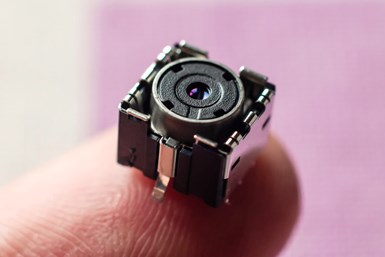Horizon Microtechnologies’ Micro AM for Conductive, Environmentally Resistant Parts
The company has developed a template-based 3D microfabrication technology that gives manufacturers the ability to add conductivity to all or selected parts of a 3D-microfabricated template.
Share
Read Next
Horizon Microtechnologies has developed a template-based 3D microfabrication technology that gives manufacturers the ability to add conductivity to all or selected parts of a 3D-microfabricated template. Photo Credit: Horizon Technologies
Horizon Microtechnologies says its template-based 3D microfabrication technology is effectively a mechanism to exploit the usefulness of polymer micro additively manufactured (micro AM) 3D microstructures (the template). This technology is well suited for previously unserved areas of industry by adding material and functionality to the microstructure, typically with a coating process.
The company says it is now involved in numerous application-specific discussions with manufacturers across a variety of industry sectors. It is said the technology meets the demand from companies that want to benefit from the advantages and opportunities that exist through the use of micro AM, but want parts that have functionality impossible due to limited palette of materials that micro AM is able to process.
“We have researched and developed our template-based 3D microfabrication technology over many years, and while this is done in consultation with manufacturers and sensitive to market demands and dynamics, only when you commercially launch can you see and assess the level of real practical interest,” says Andreas Frölich, Horizon Microtechnologies CEO. “Since announcing the commercial availability of our technology, we have been somewhat overwhelmed by the highly qualified and application-specific nature of the conversations we are now having with customers.”
Frölich says the reason for this is to be expected in that its technology largely enhances the functionality of additive manufacturing (AM), specifically micro AM, which has only recently evolved into a repeatable and reliable area of AM for industrial applications.
“AM has been recognized across industry as affording manufacturers access to an agile, cost-effective and versatile technology that promotes hitherto impossible geometric complexity while at the same time democratizing manufacturing,” Frölich adds. “Our template-based 3D microfabrication technology opens up the power of AM to sectors that were until now unable to exploit it due to restricted material options, which, in turn, restricted part functionality.”
Horizon Microtechnologies has developed a post-build coating technology that builds upon the opportunities afforded through the use of micro AM-produced parts by adding functionality, specifically conductivity and environmental resistance. To introduce conductivity, once the part is produced on a polymer AM platform, it is either wholly or selectively coated with a conductive layer.
The company can even coat difficult areas homogeneously, such as long narrow channels and undercuts. In addition, microfabricated 3D templates can also be coated with metal oxides to make parts compatible with aggressive chemical environments and, in some cases, can notably increase the resistance to high temperatures and mechanical stresses. The ability to add conductivity to all or selected parts of a 3D microfabricated template is well suited for manufacturers of electrodes, electrical sensor heads and ESD-safe components.
“When focused specifically on electrodes, we are able to design an electrode geometry almost arbitrarily while maintaining manufacturability through the use of micro AM 3D templates,” Frölich says. “Using micro AM as opposed to traditional manufacturing processes allows for more flexibility when it comes to 3-dimensional placement of active electrode areas, stiffness (or lack of stiffness) of the electrodes and electrical properties of the electrode due to enhanced control over the inductance and capacitance. We also have the ability to make electrodes from different conductive materials to cater for biocompatibility/bioinertness.”
While Horizon’s coating process is agnostic to part geometry and complexity, if selective coating is required, this needs to be accounted for at the design stage of product development. Because of this, Horizon works with customers to optimize outcomes using design for micro AM and design for template-based microfabrication expertise.
- Listen to this episode of AM Radio as Peter Zelinski and Julia Hider zoom in on micro 3D printing, including discussion of the opportunities and challenges of 3D printing on a micro scale.
Related Content
How to Build 10,000+ Shot Molds in Hours
Rapid tooling isn’t so rapid when it takes days to 3D print a metal mold, and then you still must machine it to reach the necessary tolerances. With Nexa3D’s polymer process you can print a mold in hours that is prototype or production ready and can last for more than 10,000 shots.
Read MoreThis Drone Bird with 3D Printed Parts Mimics a Peregrine Falcon: The Cool Parts Show #66
The Drone Bird Company has developed aircraft that mimic birds of prey to scare off problem birds. The drones feature 3D printed fuselages made by Parts on Demand from ALM materials.
Read More3D Printing with Plastic Pellets – What You Need to Know
A few 3D printers today are capable of working directly with resin pellets for feedstock. That brings extreme flexibility in material options, but also requires greater knowledge of how to best process any given resin. Here’s how FGF machine maker JuggerBot 3D addresses both the printing technology and the process know-how.
Read MoreHow Large-Format 3D Printing Supports Micro-Scale Hydropower
There is potential hydroelectric power that has never been unlocked because of the difficulty in capturing it. At Cadens, additive manufacturing is the key to customizing micro-scale water turbine systems to generate electricity from smaller dams and waterways.
Read MoreRead Next
4 Ways the Education and Training Challenge Is Different for Additive Manufacturing
The advance of additive manufacturing means we need more professionals educated in AM technology.
Read MoreAt General Atomics, Do Unmanned Aerial Systems Reveal the Future of Aircraft Manufacturing?
The maker of the Predator and SkyGuardian remote aircraft can implement additive manufacturing more rapidly and widely than the makers of other types of planes. The role of 3D printing in current and future UAS components hints at how far AM can go to save cost and time in aircraft production and design.
Read MoreHybrid Additive Manufacturing Machine Tools Continue to Make Gains (Includes Video)
The hybrid machine tool is an idea that continues to advance. Two important developments of recent years expand the possibilities for this platform.
Read More









.png;maxWidth=300;quality=90)














